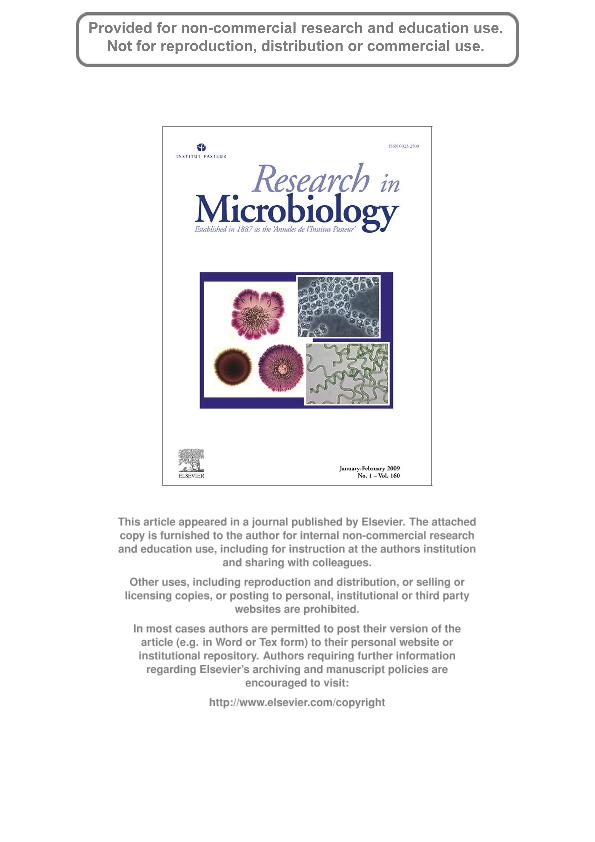Mostrar el registro sencillo del ítem
dc.contributor.author
Olivera, Nelda Lila

dc.contributor.author
Nievas El Makte, Marina Lucrecia

dc.contributor.author
Lozada, Mariana

dc.contributor.author
Del Prado, Guillermo
dc.contributor.author
Dionisi, Hebe Monica

dc.contributor.author
Siñeriz, Faustino

dc.date.available
2019-07-25T20:49:13Z
dc.date.issued
2009-01
dc.identifier.citation
Olivera, Nelda Lila; Nievas El Makte, Marina Lucrecia; Lozada, Mariana; Del Prado, Guillermo; Dionisi, Hebe Monica; et al.; Isolation and characterization of biosurfactant-producing Alcanivorax strains: hydrocarbon accession strategies and alkane hydroxylase gene analysis; Elsevier Science; Research In Microbiology; 160; 1; 1-2009; 19-26
dc.identifier.issn
0923-2508
dc.identifier.uri
http://hdl.handle.net/11336/80328
dc.description.abstract
Biosurfactant-producing bacteria belonging to the genera Alcanivorax, Cobetia and Halomonas were isolated from marine sediments with a history of hydrocarbon exposure (Aristizábal and Gravina Peninsulas, Argentina). Two Alcanivorax isolates were found to form naturally occurring consortia with strains closely related to Pseudomonas putida and Microbacterium esteraromaticum. Alkane hydroxylase gene analysis in these two Alcanivorax strains resulted in the identification of two novel alkB genes, showing 86% and 60% deduced amino acid sequence identity with those of Alcanivorax sp. A-11-3 and Alcanivorax dieselolei P40, respectively. In addition, a gene homologous to alkB2 from Alcanivorax borkumensis was present in one of the strains. The consortium formed by this strain, Alcanivorax sp. PA2 (98.9% 16S rRNA gene sequence identity with A. borkumensis SK2T) and P. putida PA1 was characterized in detail. These strains form cell aggregates when growing as mixed culture, though only PA2 was responsible for biosurfactant activity. During exponential growth phase of PA2, cells showed high hydrophobicity and adherence to hydrocarbon droplets. Biosurfactant production was only detectable at late growth and stationary phases, suggesting that it is not involved in initiating oil degradation and that direct interfacial adhesion is the main hydrocarbon accession mode of PA2. This strain could be useful for biotechnological applications due to its biosurfactant production, catabolic and aggregation properties.
dc.format
application/pdf
dc.language.iso
eng
dc.publisher
Elsevier Science

dc.rights
info:eu-repo/semantics/openAccess
dc.rights.uri
https://creativecommons.org/licenses/by-nc-sa/2.5/ar/
dc.subject
Alcanivorax
dc.subject
Alkb
dc.subject
Biosurfactant
dc.subject
Hydrocarbon Accession Mode
dc.subject.classification
Biología Celular, Microbiología

dc.subject.classification
Ciencias Biológicas

dc.subject.classification
CIENCIAS NATURALES Y EXACTAS

dc.title
Isolation and characterization of biosurfactant-producing Alcanivorax strains: hydrocarbon accession strategies and alkane hydroxylase gene analysis
dc.type
info:eu-repo/semantics/article
dc.type
info:ar-repo/semantics/artículo
dc.type
info:eu-repo/semantics/publishedVersion
dc.date.updated
2019-04-11T20:12:37Z
dc.journal.volume
160
dc.journal.number
1
dc.journal.pagination
19-26
dc.journal.pais
Países Bajos

dc.journal.ciudad
Amsterdam
dc.description.fil
Fil: Olivera, Nelda Lila. Consejo Nacional de Investigaciones Científicas y Técnicas. Centro Nacional Patagónico; Argentina
dc.description.fil
Fil: Nievas El Makte, Marina Lucrecia. Consejo Nacional de Investigaciones Científicas y Técnicas. Centro Nacional Patagónico; Argentina
dc.description.fil
Fil: Lozada, Mariana. Consejo Nacional de Investigaciones Científicas y Técnicas. Centro Nacional Patagónico; Argentina
dc.description.fil
Fil: Del Prado, Guillermo. Universidad Nacional de la Patagonia "San Juan Bosco"; Argentina
dc.description.fil
Fil: Dionisi, Hebe Monica. Consejo Nacional de Investigaciones Científicas y Técnicas. Centro Nacional Patagónico; Argentina
dc.description.fil
Fil: Siñeriz, Faustino. Consejo Nacional de Investigaciones Científicas y Técnicas. Centro Científico Tecnológico Conicet - Tucumán. Planta Piloto de Procesos Industriales Microbiológicos; Argentina
dc.journal.title
Research In Microbiology

dc.relation.alternativeid
info:eu-repo/semantics/altIdentifier/doi/http://dx.doi.org/10.1016/j.resmic.2008.09.011
dc.relation.alternativeid
info:eu-repo/semantics/altIdentifier/url/https://www.sciencedirect.com/science/article/pii/S0923250808001733
Archivos asociados
